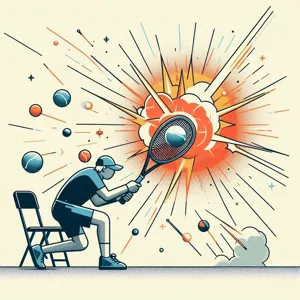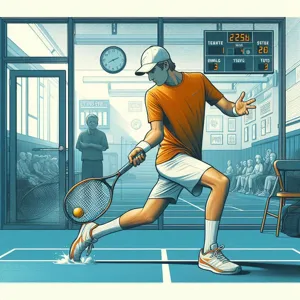Tennis is as much a mental game as it is a physical one, and one of the most critical elements that can make or break your performance on the court is your grip.
The right grip not only enhances your control and power but also allows you to express your unique playing style. With various grips to choose from—each offering distinct advantages—it can be overwhelming for players of all levels to determine which one best suits their technique and comfort. In this comprehensive guide, we’ll delve into the nuances of choosing the right tennis grip for you, exploring the different types, their benefits, and how they can impact your overall game. Whether you’re a beginner looking to establish a solid foundation or an experienced player aiming to refine your skills, understanding the intricacies of tennis grips is essential for mastering your game and elevating your performance on the court. Join us as we unlock the secrets to grip mastery!
1. Introduction to Tennis Grips

Tennis grips are the unsung heroes of your game, serving as the crucial connection between you and your racket. While many players focus on mastering their serves or perfecting their backhands, the type of grip you choose can dramatically influence your performance on the court. A grip that feels comfortable and suits your playing style can enhance your control, power, and overall enjoyment of the game.
Understanding the fundamentals of tennis grips is essential for players of all levels, from beginners just starting out to seasoned competitors looking to refine their skills. There are several types of grips—each designed to facilitate different techniques and shot types. The most common grips include the Eastern, Western, and Continental grips, each with its own unique advantages and applications.
When selecting a grip, consider factors such as your hand size, playing style, and the types of shots you prefer. A well-chosen grip can improve your grip on the racket, reduce strain on your wrist and arm, and boost your confidence during play.
In this guide, we’ll explore the various types of tennis grips, how to determine which one is the best fit for your game, and tips on making adjustments as your skills evolve. Whether you’re aiming for a powerful serve or a precise volley, mastering the right grip is the first step towards elevating your tennis experience. Get ready to unlock your potential and take your game to the next level!
2. The Importance of Choosing the Right Grip
Choosing the right grip in tennis is akin to selecting the perfect foundation for a house; it’s essential for stability and performance. The grip you opt for can dramatically influence your control, power, and overall comfort on the court. It not only affects how you hold your racket but also plays a crucial role in your swing, shot precision, and even injury prevention.
A proper grip allows for optimal racket handling, enabling you to execute a variety of strokes with finesse. Whether you’re delivering a powerful serve or elegantly slicing a backhand, the grip you choose can either enhance your performance or hinder it. For instance, a grip that is too small can lead to excessive wrist movement, affecting your accuracy and potentially resulting in injuries. Conversely, a grip that is too large can restrict your hand’s natural movement, making it challenging to generate the necessary spin and control.
Understanding the different types of grips—such as the Eastern, Western, or Continental—can help you find one that aligns with your playing style and physical attributes. Each grip offers unique benefits; for example, the Western grip is known for its ability to generate heavy topspin, while the Continental grip is favored for its versatility in executing various shots.
Ultimately, selecting the right grip is a personal journey that requires experimentation and adjustment. As you develop your skills and refine your technique, the grip that once felt perfect may evolve with your game. Therefore, dedicating time to explore and understand the nuances of different grips can greatly impact your performance and enjoyment on the court. So, take the time to find your ideal grip; it’s a fundamental step in mastering your game and achieving your tennis aspirations.
3. Overview of Common Grip Types

Choosing the right grip is essential to mastering your technique and enhancing your overall performance on the court. Each grip type offers unique advantages, catering to different playing styles and preferences. Here, we’ll explore the most common grip types used by tennis players and their distinct characteristics.
**1. Eastern Grip:**
The Eastern grip is favored by many beginners due to its versatility. To adopt this grip, place the base knuckle of your index finger on the third bevel of the racket handle. With this grip, players can easily generate topspin, making it ideal for both forehands and backhands. The Eastern grip allows for a balanced blend of power and control, making it a great choice for those looking to develop consistent strokes.
**2. Western Grip:**
For those who love to unleash powerful topspin shots, the Western grip is the go-to option. To achieve this grip, rotate your hand so that the base knuckle rests on the fifth bevel of the racket. This grip facilitates an aggressive upward swing, allowing players to impart significant topspin. While it can be challenging for beginners, mastering the Western grip can lead to impressive shot placement and depth.
**3. Continental Grip:**
The Continental grip is a favorite among advanced players for its adaptability across various shots, including serves, volleys, and overheads. To use this grip, place the base knuckle of your index finger on the second bevel. The Continental grip promotes quick transitions between different strokes, making it a versatile choice for those who engage in all-court play. This grip is particularly effective for slice shots and low balls, providing excellent control and precision.
**4. Semi-Western Grip:**
Straddling the line between the Eastern and Western grips, the Semi-Western grip is increasingly popular among modern players. By placing the base knuckle on the fourth bevel, players can achieve a comfortable balance of topspin and power. This grip allows for a fluid motion that’s effective for aggressive baseline rallies while still maintaining enough versatility for net play.
**5. Two-Handed Grip:**
While primarily associated with backhands, the two-handed grip is growing in popularity for both forehand and backhand shots. The dominant hand assumes a modified Eastern grip, while the non-dominant hand uses a Continental grip. This grip provides added stability and control, making it ideal for players who favor a powerful but accurate shot. It also allows for excellent spin and depth, particularly on the backhand side.
Understanding these common grip types will empower you to experiment and find the perfect fit for your playing style. Each grip can significantly influence your performance, so take the time to practice and discover which one feels the most natural and effective for you. As you refine your technique, remember that the right grip is a crucial step on your journey to mastering the game of tennis.
4. The Continental Grip: Versatility and Control
The Continental grip, often heralded as the Swiss Army knife of tennis grips, is a technique that offers unparalleled versatility and control on the court. This grip is achieved by placing the base knuckle of your index finger on the second bevel of the racquet handle, while your other fingers are spread comfortably around the grip. Mastering the Continental grip can elevate your game, providing you with an essential tool for a variety of shots.
One of the standout features of the Continental grip is its adaptability. Whether you’re executing a serve, volley, or overhead smash, this grip shines in its ability to handle different strokes seamlessly. It allows players to strike the ball with finesse, making it easier to hit slice shots and drop shots that can catch your opponent off guard. The grip also facilitates effective net play, empowering you to respond quickly and decisively to incoming shots.
Control is another significant advantage of the Continental grip. With your hand positioned to optimize both power and precision, you can impart a greater degree of spin and angle to your shots. This control becomes crucial during crucial moments in a match, as it enables you to place the ball exactly where you intend, whether it’s down the line or cross-court.
Additionally, the Continental grip serves as an excellent foundation for developing other grips. Once you’re comfortable with this grip, transitioning to the Eastern or Semi-Western grips for groundstrokes becomes a more natural progression, allowing you to expand your skill set further.
In summary, the Continental grip is not just a technique; it’s a gateway to versatility and control that every tennis player should explore. By integrating this grip into your game, you’ll find yourself better equipped to handle various situations on the court, ultimately leading to improved performance and greater enjoyment of the game. So grab your racquet, practice this grip, and watch as your confidence and proficiency soar!
5. The Eastern Grip: Power and Precision

The Eastern grip is a classic choice that strikes a remarkable balance between power and precision, making it a favorite among players who appreciate a straightforward approach to their game. This grip, often favored by legendary tennis icons, is achieved by placing the base knuckle of your index finger on the third bevel of the racket handle. As you hold the racket, your other fingers wrap comfortably around the handle, creating a solid, stable grip that allows for a high degree of control.
One of the standout features of the Eastern grip is its versatility. Whether you’re executing a forehand or backhand, this grip enables you to generate significant topspin while still maintaining the ability to hit flat, aggressive shots. This dynamic nature makes it particularly effective for players who enjoy dictating the pace of the game. With a well-executed Eastern grip, you can deliver powerful groundstrokes that penetrate your opponent’s defenses, forcing them into a defensive position.
Additionally, the Eastern grip is excellent for transitioning to volleys, allowing for quick adjustments at the net. Its flat angle makes it easier to hit crisp, clean shots with minimal fuss, which can be a game-changer when you’re under pressure. However, it’s worth noting that mastering this grip requires practice, as timing and footwork play crucial roles in harnessing its full potential.
As you explore the benefits of the Eastern grip, consider how it aligns with your playing style. If you thrive on aggressive play and enjoy the thrill of dictating points, this grip could be your ticket to elevating your game. Experimenting with this grip during practice sessions will help you understand its nuances, paving the way for improved performance on the court. In the realm of tennis, where every point counts, the Eastern grip offers a powerful blend of strength and accuracy that can help you outmaneuver your opponents and achieve your competitive goals.
6. The Semi-Western Grip: Spin and Comfort
### 6. The Semi-Western Grip: Spin and Comfort
The semi-western grip has emerged as a favorite among many intermediate and advanced players, striking an appealing balance between power, spin, and comfort. This grip allows players to generate significant topspin while maintaining a level of control that is crucial for effective shot placement. When using the semi-western grip, your palm sits underneath the racket handle, with your fingers spread wide, offering a comfortable and secure hold.
One of the standout features of the semi-western grip is its ability to facilitate heavy topspin shots. By positioning the racket head below the ball at contact and brushing up against it, players can achieve a high arc with their shots, making it easier to keep the ball in play while pushing opponents back behind the baseline. This is particularly advantageous on clay courts, where topspin can make the ball bounce higher and more unpredictably.
Moreover, the semi-western grip is incredibly versatile, allowing players to execute a range of strokes—from powerful forehands to defensive slices—without needing to constantly adjust their grip. This consistency can be especially beneficial in fast-paced matches where split-second decisions are vital. As you transition from a neutral position to hitting on the run, the semi-western grip provides a level of comfort that can help alleviate the strain on your wrist and forearm, reducing the risk of injury over time.
For those looking to master their game, the semi-western grip offers not just a technical advantage but also a way to express personal style on the court. With its blend of spin, control, and comfort, this grip can elevate your playing experience, allowing you to confidently attack or defend against your opponent, making it a worthy consideration for any serious tennis player.
Incorporating the semi-western grip into your training can lead to noticeable improvements in your game, but remember, like any grip, it may take time to adjust. Practice is key—experiment with it during drills and matches to discover how it can best complement your unique playing style.
7. The Western Grip: Extreme Spin and Angle

The Western grip, often viewed as one of the more advanced grips in tennis, is a powerful tool for players looking to add extreme spin and angle to their shots. This grip is characterized by placing the base knuckle of your index finger on the third bevel of the racquet handle, which shifts your hand more under the racquet compared to the Eastern grip. This unique positioning allows for a more vertical racquet face at contact, enabling players to generate significant topspin.
One of the most striking advantages of the Western grip is its ability to create heavy topspin, which can push opponents back and open up the court for angle shots. When executed properly, a ball struck with a Western grip will have a steep trajectory, dipping sharply after crossing the net and often kicking up high on the bounce. This makes it particularly effective on clay courts, where the extra spin can disrupt an opponent’s rhythm and force them into defensive positions.
However, mastering the Western grip does come with its challenges. The grip is less forgiving on low balls, requiring players to adapt their footwork and swing mechanics to handle different heights effectively. Additionally, the Western grip can make hitting flatter shots more difficult, as the extreme angle may result in the ball sailing long if not managed well.
For players who thrive on aggressive baseline play and enjoy dictating points with spin and angle, the Western grip can be a game-changer. As you incorporate this grip into your repertoire, focus on developing a fluid swing and practicing your footwork to fully harness the grip’s potential. With dedication and practice, you’ll find that the Western grip not only enhances your game but also adds an exciting dimension to your shot-making abilities on the court.
8. Factors to Consider When Choosing a Grip
Choosing the right tennis grip goes beyond mere preference; it’s a pivotal decision that can significantly impact your performance on the court. Several factors come into play when selecting a grip that complements your playing style and enhances your overall game.
**1. Grip Size:** The first step in finding the perfect grip is determining the right size. A grip that is too small can lead to increased wrist movement and loss of control, while an oversized grip can cause discomfort and fatigue. To measure your grip size, hold the racket with an Eastern grip and check if you can fit the index finger of your other hand in the space between your fingertips and the base of your palm. Finding the right fit is essential for maintaining comfort and maximizing your swing.
**2. Playing Style:** Your playing style greatly influences the grip you should choose. If you’re an aggressive player who frequently hits topspin shots, you might benefit from a grip that provides better control and stability. Conversely, if you favor a more finesse-oriented game, a grip that allows for easier touch shots might be ideal. Analyze your strengths and identify which grip supports your unique approach to the game.
**3. Material and Texture:** The materials used to make the grip can impact both feel and performance. Rubber grips offer a good blend of comfort and tackiness, while leather grips provide a firmer, more traditional feel. Additionally, consider the texture of the grip—some players prefer a smoother surface for quick adjustments, while others may opt for a more textured grip for enhanced traction during intense rallies.
**4. Climate Considerations:** The environment in which you play can also affect your grip choice. In humid conditions, a grip with moisture-wicking properties can help maintain control, while in dry weather, a more textured grip may be beneficial for preventing slippage. Think about the conditions you’ll be playing in and select a grip that can withstand the elements while providing optimal performance.
**5. Personal Preference:** Ultimately, the best grip for you is one that feels right in your hand. Spend some time experimenting with different grips during practice sessions to see which feels the most comfortable and natural. Pay attention to how each grip influences your swing, shot accuracy, and overall enjoyment of the game.
By taking these factors into consideration, you’ll be well on your way to selecting a tennis grip that enhances your performance and helps you master your game. With the right grip in hand, you’ll be ready to take on any opponent with confidence and skill.
9. Analyzing Your Playing Style and Goals
When it comes to mastering your game on the tennis court, understanding your playing style and goals is crucial in selecting the right grip. Each player brings a unique blend of strengths, weaknesses, and preferences to the game, and these factors should guide your choice of grip.
Start by reflecting on your playing style: Are you an aggressive baseliner who relies on powerful groundstrokes, or do you prefer a more strategic approach, utilizing finesse and placement? If you thrive on generating topspin and rallying from the back of the court, a semi-western or western grip might serve you well, allowing for greater racket head speed and spin potential. On the other hand, if you’re a serve-and-volley player, a continental grip could offer the versatility needed for quick transitions at the net.
Next, consider your goals. Are you aiming to compete at a higher level, or are you playing for leisure and enjoyment? Competitive players often benefit from grips that enhance their control and precision, enabling them to execute complex shots under pressure. If you’re just starting out or playing casually, a more forgiving grip that allows for a wider margin of error may be preferable, helping you build confidence and enjoyment in your game.
Analyzing your physical attributes is also essential. Hand size, finger length, and strength can all influence how comfortable a grip feels in your hand. A grip that’s too large may hinder your maneuverability, while one that’s too small might lead to discomfort or injury over time. Take the time to experiment with different grip sizes and styles to find what feels best for you.
Ultimately, the right grip should enhance your strengths while accommodating your playing style and goals. By taking a thoughtful approach to this aspect of your game, you’ll not only improve your performance but also deepen your love for the sport. Remember, the journey to mastering your game begins with understanding your unique playing identity.
10. How Grip Size Affects Your Game
Choosing the right grip size is crucial in mastering your tennis game, and it can significantly impact your performance on the court. A grip that is too small can lead to excessive wrist movement, resulting in a lack of control and potential injuries, such as tennis elbow. Conversely, a grip that is too large can cause your hand to cramp, inhibiting your ability to generate power and spin on your shots.
The grip size affects not only your comfort but also your overall technique. With the correct grip, you’ll find it easier to hold the racket firmly without overexerting yourself. This can enhance your shot accuracy, allowing you to place the ball precisely where you intend. Additionally, a proper grip size plays a vital role in your ability to execute different types of strokes. For instance, players with a smaller grip size often find it easier to create topspin due to the increased wrist flexibility, while those with larger grips may struggle to impart the same degree of spin.
To determine your ideal grip size, consider measuring the distance from the tip of your ring finger to the second crease of your palm. This measurement can guide you towards the right grip size, but personal preference also plays a significant role. Some players prefer a slightly smaller grip for better maneuverability, while others might opt for a larger grip for added stability.
Ultimately, finding the perfect grip size is about trial and error. Experimenting with different sizes during practice sessions will help you discover which grip feels most natural and allows you to play your best game. Remember, the right grip can make all the difference in your performance, transforming your swings from awkward to effortless, and giving you the confidence to dominate the court.
11. Techniques for Testing Different Grips
When it comes to finding the perfect tennis grip that complements your playing style, experimentation is key. Understanding your options and testing various grips will not only enhance your comfort on the court but also elevate your overall performance. Here are some effective techniques for testing different grips to help you make an informed choice.
**1. The Basic Grip Test:** Start by holding the racket with each grip type for a few minutes while standing in a relaxed position. Pay attention to how each grip feels in your hand. Is it comfortable? Does it feel secure? This preliminary test can give you a quick sense of which grips feel more natural.
**2. Shadow Swings:** Once you’ve narrowed down a few grips that feel promising, take them for a test drive with shadow swings. Stand in a relaxed stance and mimic your strokes without a ball. Focus on your forehand and backhand motions, noting how each grip affects your swing path, wrist movement, and overall fluidity. This exercise helps you visualize how each grip will function during a real game.
**3. Hitting Drills:** The best way to truly assess a grip is by hitting balls. Find a partner or head to the practice wall and spend time hitting forehands, backhands, volleys, and serves using each grip. Pay attention to how the racket responds during contact—does the ball feel controlled? Are your shots more powerful or accurate? This active testing phase will provide a tangible sense of the grip’s performance in real gameplay.
**4. Game Simulation:** To take your testing further, simulate match scenarios. Play practice sets or games while switching grips between points. Observe how each grip influences your game under pressure. This not only gives insight into comfort but also how well you can adapt to the grip during competitive play.
**5. Solicit Feedback:** Don’t hesitate to ask for feedback from practice partners or coaches. They can provide valuable insights into how your grip affects your strokes and overall game. Sometimes, an outside perspective can highlight details you may overlook.
**6. Keep a Journal:** Document your findings as you test different grips. Note what you like or dislike about each one, along with the specific shots that feel better or worse. Over time, this record will help you identify patterns, leading you closer to the grip that suits your style.
By employing these techniques, you’ll not only discover which grip enhances your comfort but also how it can improve your performance on the court. Remember, finding the right grip is a personal journey, and with patience and practice, you’ll be equipped to master your game.
12. Adapting Your Grip for Different Shots
Mastering your grip is crucial for enhancing your performance on the court, and one of the most vital skills to develop is the ability to adapt your grip for different shots. Each stroke in tennis—be it a forehand, backhand, serve, or volley—requires a nuanced approach to grip in order to achieve optimal power, spin, and control.
For instance, when executing a forehand, many players prefer the semi-western grip, which allows for a natural flow of the wrist and excellent topspin. However, when you need to play a low ball or respond quickly at the net, transitioning to an eastern grip can provide the flat trajectory and quick snap necessary for powerful strikes. This adaptability not only enhances your shot-making ability but also increases your effectiveness in various game situations.
Similarly, your grip for serves can vary based on the type of serve you wish to execute. A continental grip is typically favored for serves, as it promotes a more fluid motion for both flat serves and spins. But if you’re looking to add a slice to your serve, a slight adjustment to your grip can help generate that desired spin and make your serve more unpredictable to your opponent.
Don’t forget about the backhand! Whether you’re using a one-handed or two-handed backhand, the grip can greatly influence your shot. A one-handed backhand often benefits from an eastern or continental grip for a classic feel, while a two-handed backhand typically uses an eastern grip with the dominant hand and a continental grip with the non-dominant hand.
Practicing these grips during drills will help you become more comfortable and instinctive in your adjustments during match play. Remember, each grip change may feel awkward at first, but with repetition, you’ll build muscle memory and confidence, allowing you to adapt seamlessly and respond to the dynamic nature of a tennis match. By mastering the art of adapting your grip, you’ll not only improve your shot precision but also elevate your overall game, making you a more versatile and formidable opponent on the court.
13. Transitioning Between Grips: When and Why
Transitioning between grips is a crucial skill that can elevate your game and enhance your performance on the court. While it may seem daunting at first, understanding when and why to switch grips can lead to more versatile shot-making and a deeper strategic approach to your gameplay.
As you advance in your tennis journey, you’ll encounter various scenarios where a specific grip can make all the difference. For instance, while the eastern grip may be your go-to for powerful forehands, you might find that transitioning to a semi-western grip can provide better topspin and control during baseline rallies. Recognizing the type of shot you wish to execute—be it a slice, volley, or overhead—will influence your grip choice.
Timing is equally important; the moment before contact with the ball is often your best opportunity to adjust your grip. If you’re moving forward for a volley, switching to an eastern grip can help you cut through the ball and add precision. Conversely, as you retreat to the baseline, transitioning back to a semi-western or full western grip can enhance your ability to generate spin and depth.
Moreover, understanding the nuances of different grips can also help you anticipate your opponent’s shots. For example, if you’re facing a player who frequently employs heavy topspin, adjusting to a firmer grip can improve your stability and response time, allowing you to counter effectively.
Experimenting with grip transitions during practice is essential. By incorporating drills that challenge you to switch grips fluidly and without hesitation, you’ll develop muscle memory that will serve you well in match situations. Remember, mastering grip transitions is not just about technique; it’s about embracing the dynamic nature of the game and being prepared to adapt to any situation that arises on the court. With consistent practice and a keen understanding of when and why to switch grips, you’ll gain a competitive edge that sets you apart from your opponents.
14. Maintaining and Caring for Your Grip
Maintaining and caring for your tennis grip is an often-overlooked aspect of enhancing your performance on the court. A well-maintained grip not only provides better control and comfort but also extends the life of your racquet. Here are some essential tips to ensure your grip stays in optimal condition.
First and foremost, cleanliness is key. After each playing session, take a moment to wipe down your grip with a damp cloth to remove sweat, dirt, and oils from your hands. This will help prevent the grip from becoming slippery and reduce the buildup of grime that can lead to wear over time. For grips made of leather, a gentle leather cleaner can be used occasionally to keep the material supple.
Next, consider the environment in which you play. If you frequently play in humid conditions, your grip may absorb moisture, leading to a sticky feel that can hinder your performance. In such cases, using a moisture-wicking overgrip can help manage sweat and enhance your hold on the racquet. Conversely, if you play in dry conditions, applying a small amount of grip powder can improve your traction and prevent your hands from slipping.
Another important aspect of grip care is monitoring its wear and tear. Over time, grips can become worn down, frayed, or lose their tackiness. Regularly inspect your grip for signs of damage, and be proactive about replacing it when necessary. A worn grip can not only affect your game but can also lead to blisters or discomfort during play.
Lastly, consider storing your racquet properly when it’s not in use. Keeping your racquet in a protective cover and avoiding extreme temperatures will help maintain the integrity of your grip. By taking these simple steps, you can ensure that your grip remains in top condition, allowing you to focus on your game without distractions. With a little attention and care, your grip will serve you well, providing the support and confidence you need to master your shots on the court.
15. Conclusion: Finding Your Perfect Grip for Success
In conclusion, finding your perfect tennis grip is not just about comfort; it’s a crucial element that can significantly influence your game. As we’ve explored throughout this guide, the right grip can enhance your control, power, and overall performance on the court. Whether you gravitate towards the classic Eastern grip for its versatility, the Western grip for heavy topspin, or the continental grip for a well-rounded approach, the key is to ensure that your choice aligns with your playing style and physical comfort.
Remember that mastering your grip takes time and practice. Don’t be afraid to experiment with different grips to discover what feels best for you. Consider working with a coach or a more experienced player who can provide insights and help refine your technique. The grip you choose should not only empower your strokes but also foster your confidence as you step onto the court.
Ultimately, the perfect grip is one that complements your unique strengths and preferences. As you invest time in understanding and honing your chosen grip, you’ll find that it can elevate your game to new heights. So, strap on your tennis shoes, grab your racket, and take the next step toward mastering your game—your ideal grip is waiting to be discovered!
In conclusion, selecting the right tennis grip is a pivotal step toward mastering your game and enhancing your overall performance on the court. By understanding the various grip types and considering factors such as your playing style, hand size, and comfort, you can make an informed choice that will elevate your skills and confidence. Remember, the perfect grip can significantly impact your control, power, and spin, ultimately contributing to your success in matches. As you experiment with different grips and find what feels best for you, stay patient and open-minded—after all, the journey to improvement is just as important as the destination. So, lace up your shoes, grab your racket, and hit the court with renewed enthusiasm, knowing that you’re one step closer to mastering your game!












